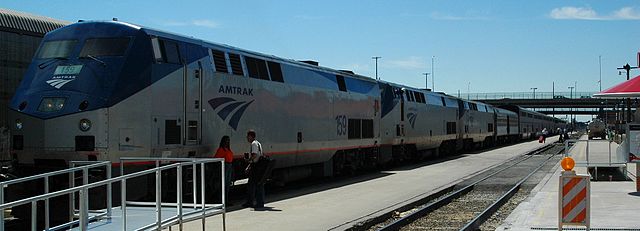Happening Now
Small Communities Rally Around Southwest Chief
January 23, 2013
Written By Sean Jeans Gail

"It's part of our life. And once it's gone, it's gone."
That is the promise and the threat that motivates Mayor David Crase in his efforts to preserve Southwest Chief service in Garden City, Kansas. It is a threat shared by many small communities along the line. In “A Kansas town tries to keep the train coming through,” CNN Contributor Bob Greene outlines how the Amtrak train has woven itself into the very fabric of the Garden City community, providing a vital connection to the rest of America:
Garden City, with a population of around 28,000, has had its own daily passenger railroad service since the town was founded in rural southwest Kansas in the late 1800s. The Atchison,Topeka & Santa Fe sent its glamorous trains through Kansas on their way east and west. Garden City built its train station right downtown.
To have the station there made the town part of the grand and glorious thread that, railroad-stop-by-railroad-stop, connected the still-young nation, the thread that made the country seem, and feel, cohesive and whole.
…
But even for residents who never use the Southwest Chief, its presence is a symbol. The whistle sounds, as it has since the 1800s, and it signals that men and women from large cities and small will be stopping, however briefly, in their town, at their station.
However, there is trouble on the horizon. The line between Newton,KS, and the Albuquerque area sees little or no freight traffic these days, and the obligation of owner BNSF Railway to maintain the tracks to acceptable passenger speeds is time-limited. As outlined in Greene’s article, BNSF says that a tipping point has been reached:
This spring, the Garden City Telegram reported, Amtrak and BNSF held a meeting in Garden City with representatives of the communities the Southwest Chief serves in those three states—towns including Dodge City, Kansas; La Junta, Colorado; Raton, New Mexico. The Telegram reported that, because of the cost of maintaining the old tracks, the Southwest Chief may, within the next several years, be switched to an entirely different BNSF route, farther south.
The sums involved are not paltry. According to the Telegram, if the Southwest Chief is to stay on its traditional route with its traditional stations, $10 million per year for track-maintenance costs and a total of $100 million for long-term improvements must be found. If not, the alternate, passenger-train-ready BNSF tracks many miles to the south beckon.
Following conversations with officials involved in the matter, it is NARP’s understanding that the $100 million could be spread over 10 years, and that a five-way split may be possible—involving BNSF Railroad, Amtrak, and the states of Kansas, Colorado and New Mexico.
While the story is a few months old, it is an excellent summary of what a transportation link can mean to a community, and well worth reading in its entirety. It also provides an important context to recent efforts to highlight the problems facing the Southwest Chief. If the current alignment is to be maintained, securing the support of the small communities served—and the weight they bring in the political process—is invaluable.
While trains are sometimes cast as an exclusively urban mode, Amtrak’s national network connects hundreds of small- and rural-communities to the larger economic markets. It’s a point demonstrated in NARP’s analysis of the national network, "Long Distance Trains: Multipurpose Mobility Machines," which uses data from the Southwest Chief service to illustrate the unique benefits of train travel, and dispel misconceptions about how passengers utilize long distance routes:
[C]onsider the 2,265 mile corridor between Chicago and Los Angeles. Critics claim that air travel has made such routes obsolete; that it would be cheaper for government to buy each passenger an airline ticket than to run trains on this route. If trains ran non-stop between these two cities, the critics might be right. But the trains do not and the critics are wrong.
This route currently has just one train a day in each direction, the Southwest Chief, yet it attracts 355,000 passengers per year—466 per departure. Because it makes 31 intermediate stops, it provides a mobility choice for twenty five million Americans who live within just 25 miles of a station (31 million who live within 50 miles) for short, medium and long distance trips between 528 different city pairs with each and every trip.
Data demonstrate that trip lengths vary from very short (as few as 10 to 40 miles) to very long (more than 2,000 miles) and everything in between. Please note that many passengers connect to other trains at Chicago, Kansas City and Los Angeles, so many trips are actually longer.
Raising awareness among the small communities that often have the most to lose is critical to broadening the base of support for passenger trains.
"The National Association of Railroad Passengers has done yeoman work over the years and in fact if it weren’t for NARP, I'd be surprised if Amtrak were still in possession of as a large a network as they have. So they've done good work, they're very good on the factual case."
Robert Gallamore, Director of Transportation Center at Northwestern University and former Federal Railroad Administration official, Director of Transportation Center at Northwestern University
November 17, 2005, on The Leonard Lopate Show (with guest host Chris Bannon), WNYC New York.
Comments